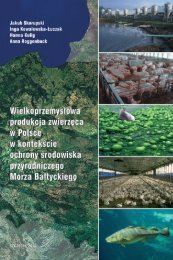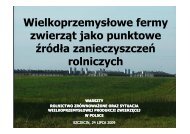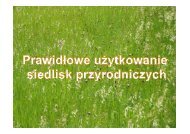best available technologies for manure treatment - Baltic Green Belt
best available technologies for manure treatment - Baltic Green Belt
best available technologies for manure treatment - Baltic Green Belt
You also want an ePaper? Increase the reach of your titles
YUMPU automatically turns print PDFs into web optimized ePapers that Google loves.
Best Available Technologies <strong>for</strong> <strong>manure</strong> <strong>treatment</strong> baltic sea 2020<br />
Best Available Technologies <strong>for</strong> <strong>manure</strong> <strong>treatment</strong> baltic sea 2020<br />
ANNEX E: TABLES WITH SHORT DESPRIPTION OF LIVESTOCK MANURE TREATMENT TECHNOLOGIES<br />
Best Available Techniques <strong>for</strong> <strong>manure</strong> <strong>treatment</strong> - <strong>for</strong> intensive rearing of pigs in <strong>Baltic</strong> Sea Region EU Member States Technical Report "Best Practice Manure Handling, Phase 2"<br />
Ref No. 46 Composting of <strong>manure</strong> with larvae of the housefly<br />
Brief description Description of the effect on leaching (positive or negative) of N and P<br />
A method <strong>for</strong> composting <strong>manure</strong> using the housefly larvae has been subject to resent<br />
research at the University of Alicante. The aim <strong>for</strong> the project is to address 3 major<br />
problems. 1. Overload of <strong>manure</strong> and nutrients in areas with dense livestock production.<br />
2. Need <strong>for</strong> high quality protein feeding. 3. Odour emissions in relation to <strong>manure</strong><br />
management. Those three problems can all be met if the <strong>manure</strong> is composed by fly<br />
larvae. More than half of the organic matter in the <strong>manure</strong> as well as the nutrients is<br />
been trans<strong>for</strong>med in to larvae, which later can be used as feeding ex. in fish farming.<br />
The residue is at odour less dry compost, easy to distribute and apply.<br />
Principally this technology can convert the main part of the N and P into flies,<br />
which is used as a feed ingredient, and thus re-circulated in the agricultural<br />
production, and eliminating the risk of being leached.<br />
Innovation stage<br />
Investment price, <br />
Basic Variable<br />
Operational<br />
costs,<br />
per tonnes<br />
per kg<br />
saved N or P<br />
leaching<br />
Complexity of<br />
implementation<br />
Research <br />
Pilot<br />
No data No data No data<br />
Practice<br />
CBMI, 2009<br />
Major references<br />
Condition <strong>for</strong> leaching<br />
reduction effect<br />
The N and P cannot be<br />
used in an<br />
environmentally safe to<br />
fertilise crops.<br />
Certainty of in<strong>for</strong>mation<br />
Prices No<br />
Effect on<br />
leaching<br />
Medium<br />
No data.<br />
Unclear, but probably the<br />
technology would require<br />
large space.<br />
69<br />
Page 71<br />
69








